Abstract
There is no information on the effect of food or concurrent drug administration on the bioavailability of oral etoposide, despite the fact that treatment is frequently administered over several days and most often in combination with other cytotoxic agents. The influence of these factors has been studied in 11 patients, receiving combination cytotoxic therapy for extensive small cell lung carcinoma. Neither food nor concurrent oral or intravenous chemotherapy had a significant effect on the mean plasma concentrations of etoposide, achieved following oral administration. Wide variation in peak plasma concentrations and in area under the concentration time curve (AUC) occurred both between and within patients. It appears unnecessary for patients receiving etoposide (at 100 mg) to fast prior to drug administration. Furthermore, oral etoposide (at 100 mg and at 400 mg) may be given in combination with other cytotoxic agents without compromising its bioavailability.
Full text
PDF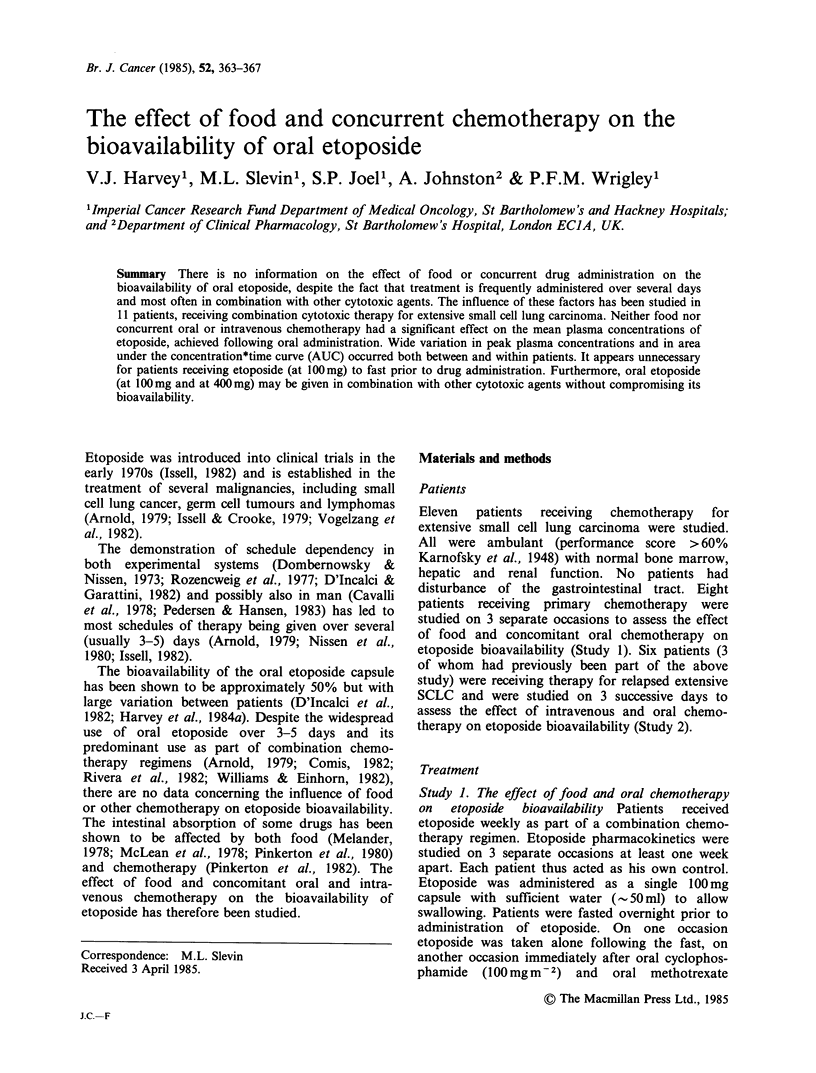
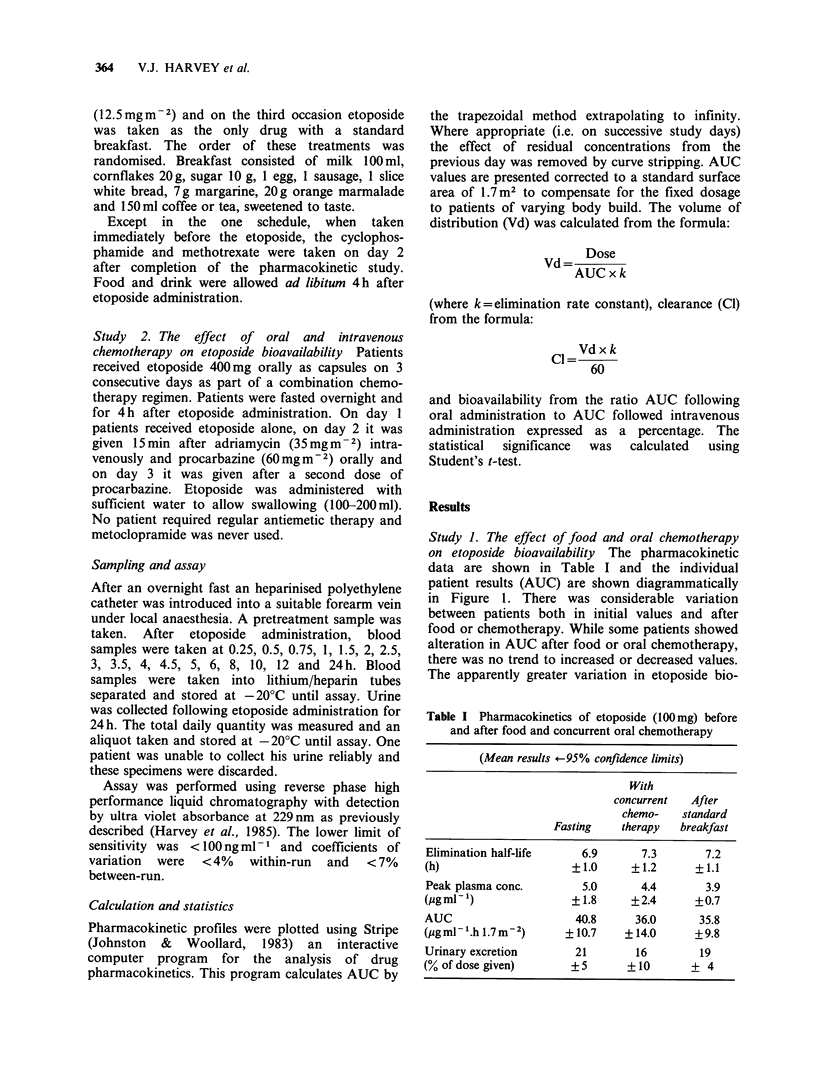
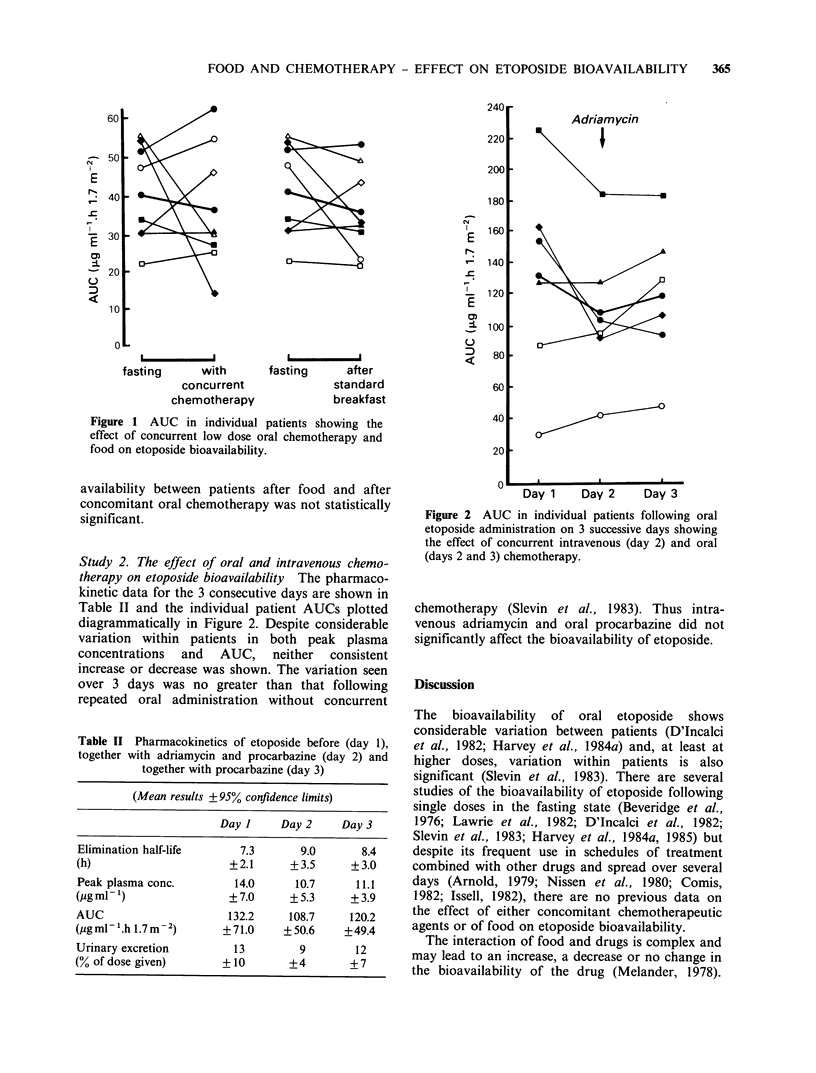
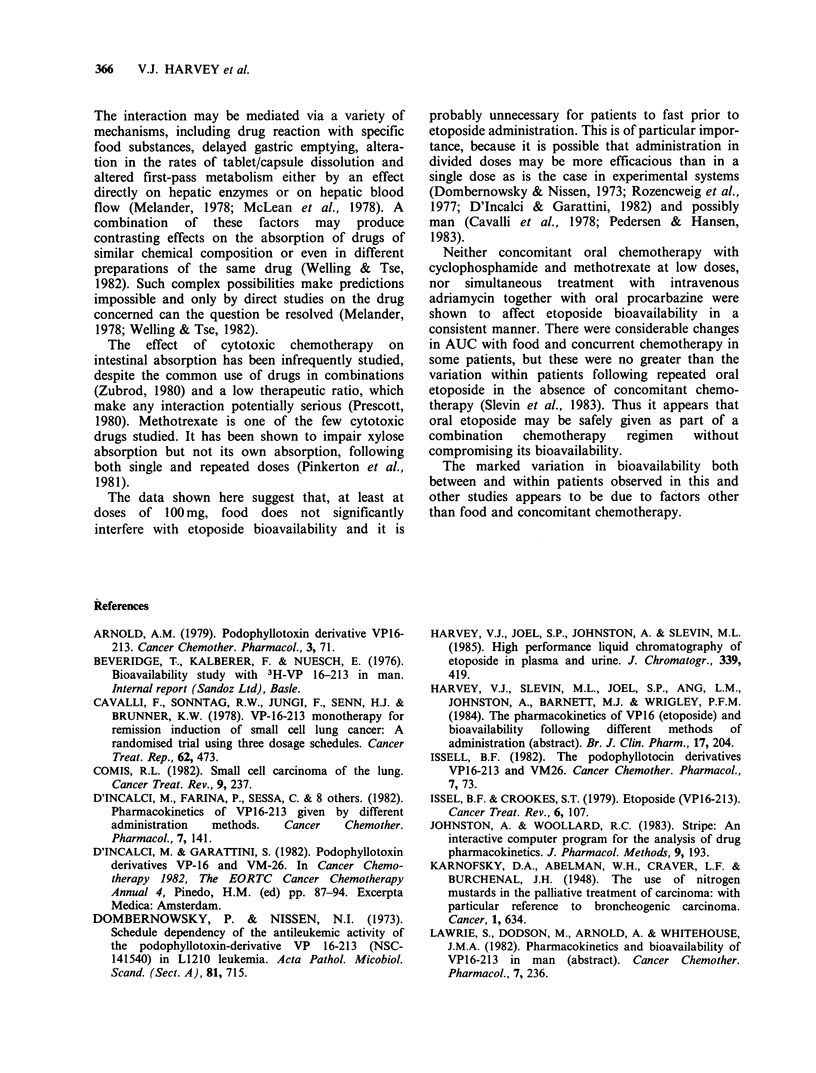
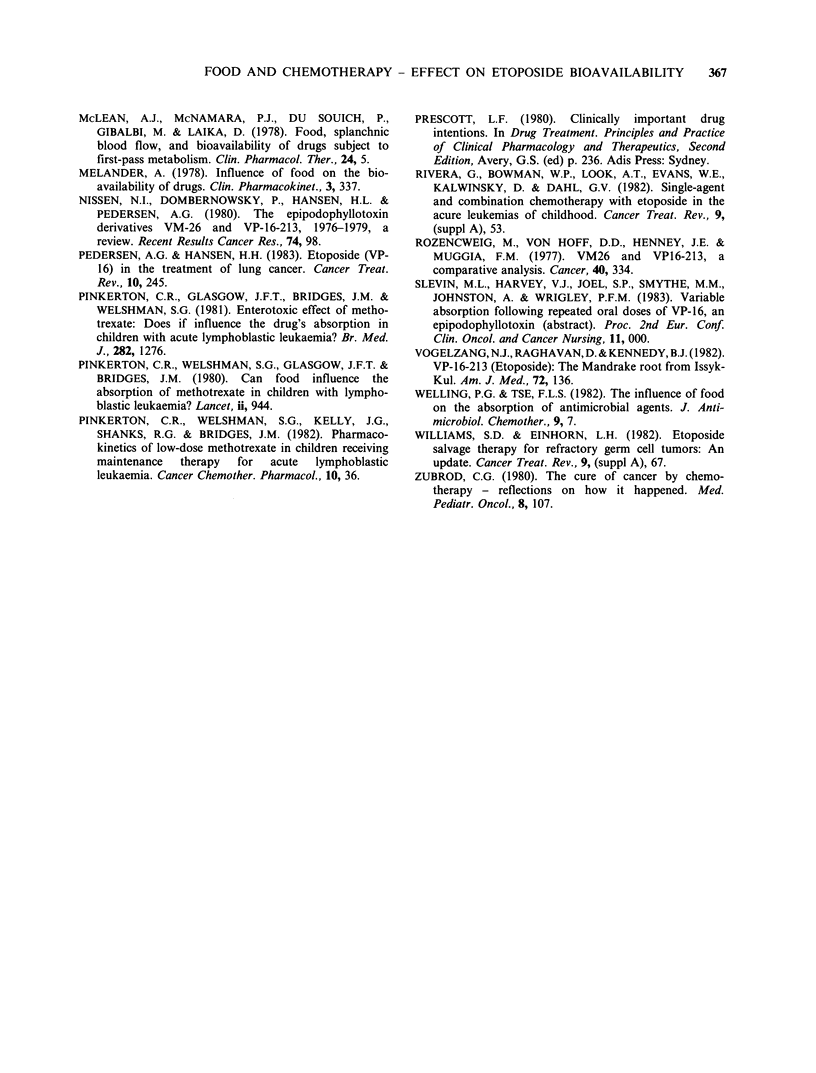
Selected References
These references are in PubMed. This may not be the complete list of references from this article.
- Arnold A. M. Podophyllotoxin derivative VP 16-213. Cancer Chemother Pharmacol. 1979;3(2):71–80. doi: 10.1007/BF00254976. [DOI] [PubMed] [Google Scholar]
- Cavalli F., Sonntag R. W., Jungi F., Senn H. J., Brunner K. W. VP-16-213 monotherapy for remission induction of small cell lung cancer: a randomized trial using three dosage schedules. Cancer Treat Rep. 1978 Mar;62(3):473–475. [PubMed] [Google Scholar]
- Comis R. L. Small cell carcinoma of the lung. Cancer Treat Rev. 1982 Sep;9(3):237–258. doi: 10.1016/s0305-7372(82)80009-1. [DOI] [PubMed] [Google Scholar]
- D'Incalci M., Farina P., Sessa C., Mangioni C., Conter V., Masera G., Rocchetti M., Pisoni M. B., Piazza E., Beer M. Pharmacokinetics of VP16-213 given by different administration methods. Cancer Chemother Pharmacol. 1982;7(2-3):141–145. doi: 10.1007/BF00254536. [DOI] [PubMed] [Google Scholar]
- Dombernowsky P., Nissen N. I. Schedule dependency of the antileukemic activity of the podophyllotoxin-derivative VP 16-213 (NSC-141540) in L1210 leukemia. Acta Pathol Microbiol Scand A. 1973 Sep;81(5):715–724. doi: 10.1111/j.1699-0463.1973.tb03564.x. [DOI] [PubMed] [Google Scholar]
- Harvey V. J., Joel S. P., Johnston A., Slevin M. L. High-performance liquid chromatography of etoposide in plasma and urine. J Chromatogr. 1985 May 3;339(2):419–423. doi: 10.1016/s0378-4347(00)84674-5. [DOI] [PubMed] [Google Scholar]
- Issell B. F. The podophyllotoxin derivatives VP16-213 and VM26. Cancer Chemother Pharmacol. 1982;7(2-3):73–80. doi: 10.1007/BF00254525. [DOI] [PubMed] [Google Scholar]
- Johnston A., Woollard R. C. STRIPE: an interactive computer program for the analysis of drug pharmacokinetics. J Pharmacol Methods. 1983 May;9(3):193–199. doi: 10.1016/0160-5402(83)90038-4. [DOI] [PubMed] [Google Scholar]
- McLean A. J., McNamara P. J., duSouich P., Gibaldi M., Lalka D. Food, splanchnic blood flow, and bioavailability of drugs subject to first-pass metabolism. Clin Pharmacol Ther. 1978 Jul;24(1):5–10. doi: 10.1002/cpt19782415. [DOI] [PubMed] [Google Scholar]
- Melander A. Influence of food on the bioavailability of drugs. Clin Pharmacokinet. 1978 Sep-Oct;3(5):337–351. doi: 10.2165/00003088-197803050-00001. [DOI] [PubMed] [Google Scholar]
- Nissen N. I., Dombernowsky P., Hansen H. H., Pedersen A. G. The epipodophyllotoxin derivatives VM-26 and VP-16-213, 1976-1979, a review. Recent Results Cancer Res. 1980;74:98–106. doi: 10.1007/978-3-642-81488-4_14. [DOI] [PubMed] [Google Scholar]
- Pedersen A. G., Hansen H. H. Etoposide (VP-16) in the treatment of lung cancer. Cancer Treat Rev. 1983 Dec;10(4):245–264. doi: 10.1016/0305-7372(83)90013-0. [DOI] [PubMed] [Google Scholar]
- Pinkerton C. R., Glasgow J. F., Bridges J. M., Welshman S. G. Enterotoxic effect of methotrexate: does it influence the drug's absorption in children with acute lymphoblastic leukaemia? Br Med J (Clin Res Ed) 1981 Apr 18;282(6272):1276–1277. doi: 10.1136/bmj.282.6272.1276. [DOI] [PMC free article] [PubMed] [Google Scholar]
- Pinkerton C. R., Welshman S. G., Glasgow J. F., Bridges J. M. Can food influence the absorption of methotrexate in children with acute lymphoblastic leukaemia? Lancet. 1980 Nov 1;2(8201):944–946. doi: 10.1016/s0140-6736(80)92105-4. [DOI] [PubMed] [Google Scholar]
- Pinkerton C. R., Welshman S. G., Kelly J. G., Shanks R. G., Bridges J. M. Pharmacokinetics of low-dose methotrexate in children receiving maintenance therapy for acute lymphoblastic leukaemia. Cancer Chemother Pharmacol. 1982 Dec;10(1):36–39. doi: 10.1007/BF00257235. [DOI] [PubMed] [Google Scholar]
- Rozencweig M., Von Hoff D. D., Henney J. E., Muggia F. M. VM 26 and VP 16-213: a comparative analysis. Cancer. 1977 Jul;40(1):334–342. doi: 10.1002/1097-0142(197707)40:1<334::aid-cncr2820400147>3.0.co;2-x. [DOI] [PubMed] [Google Scholar]
- Vogelzang N. J., Raghavan D., Kennedy B. J. VP-16-213 (etoposide): the mandrake root from Issyk-Kul. Am J Med. 1982 Jan;72(1):136–144. doi: 10.1016/0002-9343(82)90600-3. [DOI] [PubMed] [Google Scholar]
- Welling P. G., Tse F. L. The influence of food on the absorption of antimicrobial agents. J Antimicrob Chemother. 1982 Jan;9(1):7–27. doi: 10.1093/jac/9.1.7. [DOI] [PubMed] [Google Scholar]
- Zubrod C. G. The fifth Myron Karon Memorial Lecture. The cure of cancer by chemotherapy - reflections on how it happened. Med Pediatr Oncol. 1980;8(2):107–114. doi: 10.1002/mpo.2950080202. [DOI] [PubMed] [Google Scholar]


